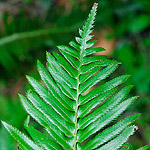 There is no better start to the day than the sense of calm and serenity one feels when walking through mature redwood groves, with large colonies of Western Sword Ferns (Polystichum munitum) growing at their feet, backlit by the early morning sun.
There is no better start to the day than the sense of calm and serenity one feels when walking through mature redwood groves, with large colonies of Western Sword Ferns (Polystichum munitum) growing at their feet, backlit by the early morning sun.
The Western Sword Fern is a native of the western United States, a member of the wood fern family, and it grows in abundance here at Curbstone Valley. These ferns can be found growing in coniferous forests from southeastern Alaska to Santa Barbara County in California, and east to parts of British Columbia, northern Idaho, and western Montana.
This fern is easily distinguished from other native ferns found here, which include Bracken Ferns (Pteridium aquilinum), and Goldenback Ferns (Pentagramma triangularis). The Western Sword Fern grows on average 2-4 feet tall and wide, though occasionally in ideal conditions can reach 6-7 feet. Young fiddlehead fronds emerge in spring, and grow out radially from the base of the plant. Individual fronds live up to 3-4 years, and remain attached to the rhizome after withering.
Each frond is made up of individual simple leaflets, or pinnae, that are lance-shaped with a serrated edge. The base of each pinna has a shape similiar to a sword hilt.
The Western Sword Fern prefers the moist understory areas where redwoods, and douglas firs predominate, and is found mostly on our east facing slopes that primarily are limited to dappled morning sun.
Some scattered ferns can be found in other areas of the property, usually growing under the canopies of Tanbark or Live Oaks.
Western Sword Ferns reproduce from spores, not seed. The ferns begin to produce spores on a regular, annual basis when they are between 1 and 5 years of age, from early to mid-summer. The plant may retain some spores over the winter which are released the following spring. Spores are contained in round sori that develop in two rows on either side of the midrib of each pinna. The spores are light yellow and borne on the wind, remaining viable for up to 4 years, but spore viability does decline with age. Ferns that are cultivated in gardens can be successfully propagated by division of the rhizomes.
Although the Western Sword Fern might be considered a common plant in this region, often sighted along shady hiking trails, near creeks and natural springs, it is unique to the western United States. Generally this fern performs poorly when cultivated in gardens in the east. It prefers the acidic soils found in western coniferous forests, and the milder temperate climate of the west. In eastern gardens the fronds often freeze and are killed to the ground, weakening the plant, resulting in poor growth the following spring.
Sword ferns provide important cover for birds and ground-dwelling wildlife, and although generally deer resistant, deer and elk may occasionally browse on young fronds.
Beyond its aesthetic value, this plant has been of significant importance to Native American peoples, and many uses of Western Sword Ferns have been documented. The Southern Kwakiutl, and Coast Salish Indians of British Columbia used the fronds to line food storage boxes, berry picking baskets and drying racks. The Makah would use them to steam salmonberry sprouts on hot rocks to infuse the sprouts with flavor. The Nitinaht, Makah and Ozette peoples placed fronds above and below food in steaming pits. The Quileute would peel and pit-bake the rhizomes, and serve them with dried or fresh salmon eggs, and the Nitinaht would steam bake large root stocks in the summer. The Pomo would use the fronds of the Western Sword Fern for lining the top and bottom of earth ovens for baking acorn bread. The fern fronds have a natural non-stick quality, and were used by the Hesquiat Indians as a mat under fish when cleaning and cutting, to help keep the fish clean[1].
The Sword Fern was also used for its medicinal qualities. Infusions of the stems, or poultices of chewed leaves were used to treat skin sores and boils by the Quileute, and Quinault. The Quinault also used a decoction of rhizomes as a wash for dandruff. Leaves were chewed by Lummi women to hasten childbirth, and the Swinomish tribe would chew leaves as a remedy for sore throats or tonsillitis[1].
The fronds had other uses as well, including by the Yurok, Tolowa, and Karok Indians as bedding. The Salish Indians would use larger leaves to cover their floors, and the Paiutes of Oregon would use Western Sword Fern fronds to decorate graves[1].
Although Western Sword Ferns grow wild here at Curbstone Valley, their beauty, coupled with their robust and resilient nature, tolerance of poor soils, and low light conditions, make them a valuable addition to any western woodland garden.
[1] Daniel E. Moerman’s Native American Ethnobotanical Database

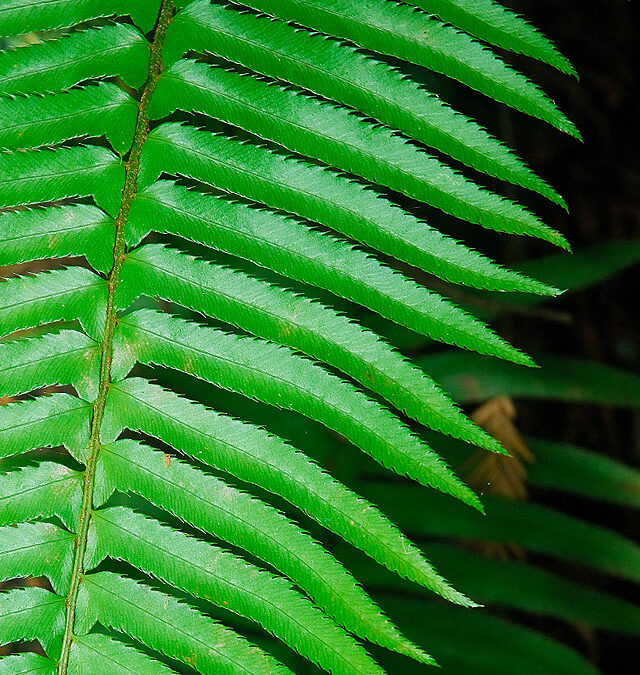
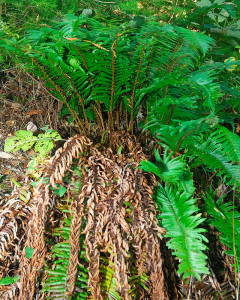

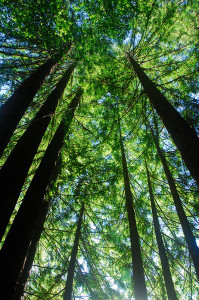
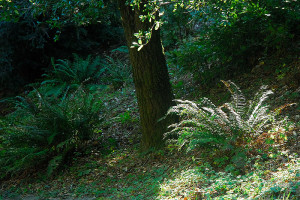
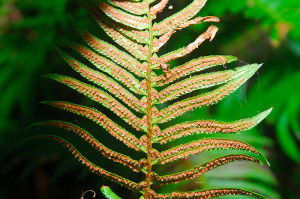








What a great post! I love that fern, though mine seem to not so as well as they might in the garden. But I hope they’ll perk up with the winter rains.
Wow, we’re neighbors – only I have the inverse of your environment: we’re on a ridge and pretty dry and you are in a valley with creeks running through. How marvelous to compare and contrast! I loved your post – I plan to do posts on our native ferns also. We have a little sword fern on our shady north slope. We get a lot of coastal wood fern, even in the chaparral, as well as coffee fern, bracken fern, golden-back fern, and polypody. Best of luck with your farm – I’d love to be your customer when you get going. I don’t do veggies because of all the veggie predators here. I guess I like watching the bunnies more than I like veggie gardening. Maybe in the greenhouse 😀 I’m going back to read your post more slowly now…
we had alot of these beautiful ferns when i lived in sonoma county in the forests….i do love those ferns and miss them, they were beautiful textures in the wild…